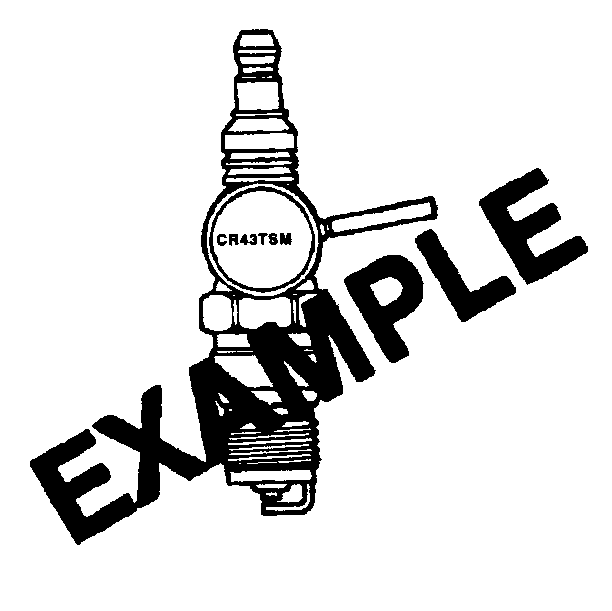Worn or dirty plugs give satisfactory operation at idling speed, but under operating conditions they frequently fail. Faulty plugs are indicated in a number of ways:
| • | Poor fuel economy |
| • | Power loss |
| • | Loss of speed |
| • | Hard starting |
| • | Poor engine performance |
Spark plugs may also fail due to the following conditions:
| • | Carbon fouling |
| • | Excessive plug gap |
| • | Broken insulators |
Fouled plugs are identified by black carbon deposits. The black deposits are usually the result of slow-speed driving and short runs where sufficient engine temperature is seldom reached. Worn pistons, rings, faulty ignition, over-rich air/fuel mixture and spark plugs which are too cold will also result in carbon deposits. Excessive gap wear, on plugs of low mileage usually indicated the engine is operating at high speeds or loads that are consistently greater than normal or that a plug which is too hot is being used. Electrode wear may also be the result of plug overheating due to insufficient spark plug torque or too much spark plug torque. An excessively lean air/fuel mixture will also result in excessive electrode wear.
Broken insulator are usually the result of improper installation or carelessness when regapping the plug. Broken upper insulators usually result from a poor fitting wrench or an outside impact. The cracked insulator may not show up right away, but will as soon as oil or moisture penetrates the crack. The crack may not be visible. Broken lower insulators usually result from carelessness when regapping and generally are visible. This type of break may result from the plug operating too hot, which may happen in periods of high-speed operation or under heavy loads. When regapping a spark plug, always make the gap adjustment by bending the ground (side) electrode. Spark plugs with broken insulators should always by replaced.
Resistor type spark plugs with tapered seats are used. No gasket is needed on these plugs. These spark plugs are a High Efficiency (HE) spark plug that has a fine wire electrode, nickel plated shell and a platinum pad across from the electrode.

- Normal service is a mixture of idling, low speed, and high speed operation.
- The heat resistant, insulating boot covers the spark plug terminal.
- Corona discharge is a steady blue light appearing (in darkness) around the insulator, just above the shell crimp.
| • | Occasional high speed driving is essential to good spark plug performance. |
| • | Increased combustion heat burns away excess carbon deposits, which accumulate from frequent idling or stop-and-go driving. |
| • | The boot extends over a portion of the spark plug insulator. |
| • | These boots prevent engine misfiring. |
| • | Do not mistake this for a shorted insulator. |
| • | This is visible evidence of a high-tension field. |
| • | This has no effect on ignition system performance. |
| • | This discharge repels dust particles. |
| • | This leaves a clear ring on the insulator just above the shell. |
| • | This is not evidence that combustion gases are escaping. |
Step | Action | Value(s) | Yes | No |
|---|---|---|---|---|
DEFINITION: A visual inspection of the spark plug firing end. | ||||
1 |
Do you see a brown to grayish tan deposit with a slight electrode wear? | -- | ||
2 |
Is the repair complete? | 1.524 mm (0.060 in) | System OK | -- |
3 | Do you see dry, fluffy, black carbon deposits? | -- | ||
4 | This indicates poor ignition output, refer to Spark Plug Wire Resistance . Is the ignition coil(s) to the spark plug connections OK? | -- | -- | |
5 | Repair or install new parts as necessary. Is the repair complete? | -- | System OK | -- |
6 | Do you see wet, oily deposits with very little electrode wear? | -- | ||
7 |
Degrease, gap and reinstall the spark plug. | 1.524 mm 0.060 in | ||
8 | Do you see red, brown, yellow and/or white colored coatings on the insulator? | -- | ||
9 | These are the by-products of combustion. Is the insulator heavily coated? | -- | ||
10 |
Is the repair complete? | 1.524 mm (0.060 in) | System OK | -- |
11 | Are there heavy deposits of dark colored coatings, especially on the side of the plug facing the intake valve? | -- | ||
12 |
Is the repair complete? | -- | System OK | -- |
13 | Is there a shiny, yellow glaze coating on the spark plug insulator? | -- | ||
14 |
Is the repair complete? | 1.524 mm (0.060 in) | System OK | -- |
15 | Are the insulator tips blistered or burned? | -- | -- | |
16 | Are the electrodes badly eroded? | -- | -- | |
17 |
Is the plug heat range correct? | -- | ||
18 | Check the torque value to ensure good spark plug seat contact. Refer to Fastener Tightening Specifications Are the spark plugs tightened according to specifications? | -- | ||
19 | Check for a misfiring engine, refer to DTC P0230 Fuel Pump Relay Control Circuit for V6 or DTC P0300 Engine Misfire Detected for V8 in Engine Controls. Is the vehicle operating properly?. | -- | ||
20 |
Is the repair complete? | -- | System OK | -- |
21 | Gap and install the correct spark plug(s). Refer to Spark Plug Usage . Is the repair complete? | -- | System OK | -- |
